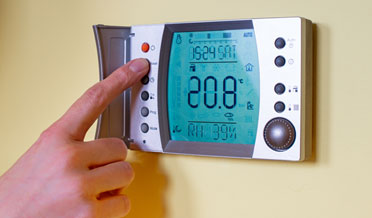Zoned HVAC Systems
Summer and Winter in the Same House
In multi-story homes, the temperature difference between the lower and upper levels can easily vary by 10 degrees. If the thermostat is downstairs and set for a reasonable warm comfort level, the upper level can be uncomfortably hot. If you adjust the thermostat to bring a comfort level to the upstairs spaces, the lower level is too cool for comfort. It can be like two seasons in one home. Here are a few solutions you might consider:
Zoned HVAC Systems
This solution calls for a separation of the upper and lower levels into two spaces, creating two heating/cooling zones. The comfort setting can be set at the same temperature (with successful results) or set at a different setting for each level. Many people prefer to sleep in cool rooms; a one-zoned system makes that difficult. Zoned HVAC systems can be accomplished using one of several methods.
- Mini-split ductless HVAC systems. This technique adds an additional heat pump that connects to as many as 4 wall-mounted units that can heat and cool a normal-sized room. Each room can be individually controlled with an in-room Zoned HVAC System thermostat. The majority of the construction remains on the outside of the house, with a sleek indoor blower unit to evenly distribute conditioned air.
- Electronically adjusted dampers. Dampers work like valves inside your existing ducts; they open and close, controlling air movement during both heating and cooling season. This solution uses the existing Zoned HVAC System and existing ducts. It achieves better control of comfort for each level.
- Multiple systems. The next time you replace your HVAC system, you might consider purchasing two smaller units, with unique Zoned HVAC System thermostats for each level. This solution will require some ductwork adjustments; expect some minor construction to rearrange ductwork. This is probably the most expensive solution, but you will be pleased with the results.
Maximizing the Potential of Zoned HVAC Systems
If your HVAC system was sized and installed correctly, the contractor should have taken the added story into consideration while designing the system. If you are ready for a little detective work, look around for underlying issues that overload the system, resulting in uneven temperatures.
- Attic insulation. If you can see exposed ceiling joists in your attic, you have insufficient insulation. This might be caused by settling or by air currents from attic vents. As much as 85% of your home energy loss goes through the attic. Whether you do it yourself or call in a profession, this is the place to start.
- Blocked soffit vents. While you are in the attic, investigate whether soffit vents are closed off by loose insulation. This will reduce the ventilation in your attic and can keep the second story warmer than expected.
- Covered registers and vents. Conditioned air is circulated by the HVAC system through supply registers, generally found on the floor and return air vents, usually found on central hallways, a little overhead height. It is not uncommon for homeowners to ignore these essential tools for circulation.They might be covered by furniture, drapes, or rugs; the reduced airflow might be causing the temperature imbalance. Closing the vents, say in an unused room, impedes circulation and is not recommended.
- Use the “On” setting. On your thermostat, you will find two fan settings: “Auto” and “On”. The “Auto” setting only activates the blower motor while the system is heating or cooling air for circulation. The “On” setting keeps the fan running continuously, resulting in increased circulation and ventilation.The “On” setting can balance the air temperatures and increase the comfort level throughout the home. As a bonus, the cost to run the fan continuously is lower than the cost of increased furnace or AC activation.
- Leaking air ducts. The ductwork throughout your house might have moved and that movement might have caused gaps and openings within the walls. Even a few duct leaks can seriously alter the amount of properly conditioned air circulating through the house by 20-30%. While you can learn to test your ductwork for leaks, it will require a professional to seal them.
The real solution to the imbalance problem might include both methods.
Questions About Zoned HVAC Systems?
Our four decades of experience as an HVAC System maintenance contractor, AirPro Houston provides you with the skill and expertise to assist in Zoned HVAC System decisions.
We have several financing options available with great options with up to 72-month terms with approved credit. Call us today at 281-880-8805 and let us partner with you for all of your HVAC repair and installation needs.
